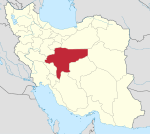Khaju Bridge
| Khaju Bridge | |
|---|---|
 | |
| Coordinates | 32°38′12″N 51°41′00″E / 32.6368°N 51.6833°ECoordinates: 32°38′12″N 51°41′00″E / 32.6368°N 51.6833°E |
| Crosses | Zayanderud |
| Locale | Isfahan, Iran |
| Characteristics | |
| Design | Arch bridge |
| Material | Stone and brick |
| Total length | 137m |
| Width | 12m |
| No. of spans | 21 |
| History | |
| Construction end | 1650 |
The Khaju Bridge (Persian: پل خواجو, Pol-e Xāju) is one of the historical bridges on the Zayanderud, the largest river of the Iranian Plateau, in Isfahan, Iran. Serving as both a bridge and a weir, it links the Khaju quarter on the north bank with the Zoroastrian quarter across the Zayanderud. It also served a primary function as a building[1] and a place for public meetings.[2] It has been described as the city's finest bridge.[2]
The mausoleum of Arthur Pope and his wife Phyllis Ackerman is situated nearby.
History
The Khaju Bridge was built around 1650, under the reign of Abbas II, the seventh Safavid king (shah) of Iran, on the foundations of an older bridge. The existing inscriptions suggest that the bridge was repaired in 1873. There is a pavilion located in the center of the structure, inside which Abbas II would have once sat, admiring the view.[2] Today, remnants of a stone seat is all that is left of the king's chair.
In words of Arthur Pope and Jean Chardin, Khaju is "the culminating monument of Persian bridge architecture and one of the most interesting bridges extant ... where the whole has rhythm and dignity and combines in the happiest consistency, utility, beauty, and recreation."[3]
Structure
The bridge has 23 arches, and is 133 meters long and 12 meters wide. It was originally decorated with tilework and paintings, and served as a teahouse. The pass way of the bridge is made of bricks and stones with 21 larger and 26 smaller inlet and outlet channels, and is 7.5 meters wide. The pieces of stone used in the bridge are over 2 meters long, and the distance between every channel and the ceiling base is 21 meters.
There are several sluice gates under the archways, through which the water flow of the Zayanderud is regulated. When the sluice gates are closed, the water level behind the bridge is raised to facilitate the irrigation of the many gardens along the river upstream of the bridge. On the upper level of the bridge, the main central aisle was utilized by horses and carts, and the vaulted paths on either side by pedestrians. Octagonal pavilions in the center of the bridge on both the down and the upstream sides provide vantage points for the remarkable views. The lower level of the bridge may be accessed by pedestrians and remains a popular shady place for relaxing.
Iranian architects have raised concerns about damage inflicted on the bridge during recent "improvement program" renovations, citing, among other problems, the destruction of the original stepped base of the bridge, the alterations made to the riverbed, and the removal of the Safavid inscribed stone blocks from the bridge.[4][5]
Gallery
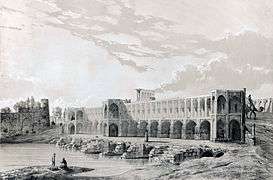 The Khaju Bridge as depicted by Eugène Flandin in 1840.
The Khaju Bridge as depicted by Eugène Flandin in 1840.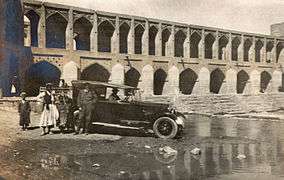 The Khaju Bridge in the early 20th century.
The Khaju Bridge in the early 20th century.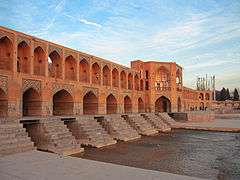 A view of the Khaju Bridge in January 2010.
A view of the Khaju Bridge in January 2010. One of the two stone lions of the Khaju Bridge.
One of the two stone lions of the Khaju Bridge.- Arches under the Khaju Bridge.
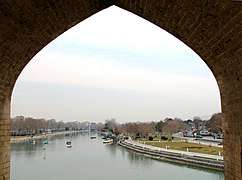 A view seen from within the Khaju Bridge.
A view seen from within the Khaju Bridge.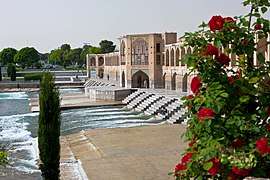 A view of the Khaju Bridge in April 2012.
A view of the Khaju Bridge in April 2012. A view of the bridge and the Zayanderud at sunset.
A view of the bridge and the Zayanderud at sunset.- A view of the walkway on the Khaju Bridge at night.
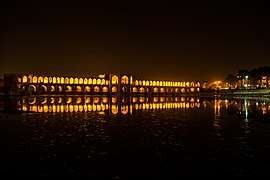 A wide view of the Khaju Bridge at night.
A wide view of the Khaju Bridge at night.
See also
- Si-o-se-pol, another such bridge on the same river
- Putra Bridge, a bridge in Malaysia that was inspired by Khaju
References
- ↑ Mainstone, Rowland J. (1998). Developments in Structural Form. Architectural Press. p. 261.
- 1 2 3 Burke, Andrew; Elliot, Mark (2008). Iran. Lonely Planet. p. 243.
- ↑ Sir John Chardin, Ronald W. Ferrier (1996). A Journey to Persia: Jean Chardin's portrait of a seventeenth-century empire. I.B.Tauris. p. 149.
- ↑ Parsipour, Mehrdad (20 July 2010). "Critiquing Recent Renovations of the Khaju Bridge in Esfahan, Iran". Green Prophet. Retrieved 21 March 2011.
- ↑ Farrokh, Kaveh. "'Restoration' damages at Pole Khaju in Isfahan".
Further reading
- Blair, Sheila S.; Bloom, Jonathan M. (1994). The Art and Architecture of Islam. New Haven: Yale University Press.
- Michell, George (1978). Architecture of the Islamic World. London: Thames and Hudson.
External links
| Wikimedia Commons has media related to Khaju Bridge. |
